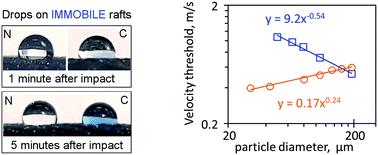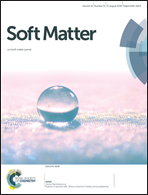Rupture of granular rafts: effects of particle mobility and polydispersity†
Abstract
Reversible encapsulation of liquid materials is a technical challenge in many applications such as for the transport and controlled delivery of active ingredients. In contrast to most state-of-the-art processes, capillary adsorbed solid particles can achieve chemical-reaction-free encapsulation by forming dense rafts which isolate the liquid from its surroundings. While the production conditions of such capsules have been characterized, the control of the armor robustness remains poorly described and understood. In this paper, we probe the armor robustness via impacts of droplets on encapsulated materials. Thereby, we establish the mechanisms and conditions of armor rupture and derive models that predict the rupturing thresholds or probabilities. Using monodisperse sized particles and gradually increasing the impacting drop velocity, a sharp transition from sustained to coalescing drops is observed. On mobile rafts made of particles at the water/air interface, the velocity threshold increases with increasing particle diameter while an opposite trend is observed on immobile rafts made of particles trapped at a gelified interface. Two models based on particle pair and triplet interactions, respectively, quantitatively match the experiments. Assembling rafts with particles of two different sizes significantly smoothens the coalescence transition, regardless of particle mobility. Beyond apparent similarities, rationalizing the rupturing probability of mobile and immobile armor evidences very different sensitivity to heterogeneities. On immobile armor, drop coalescence remains random and thus well described by the statistical particle distribution while on mobile armor the ruptures are preferably localized at the non-percolated parts of the granular network.



 Please wait while we load your content...
Please wait while we load your content...